Reviewed by Lexie CornerMay 17 2024
In a recent study published in Science, researchers from the University of Houston and Rice University found ways to predict band convergence in different materials. They also designed materials using p-type Zintl compound to increase thermoelectric performance, resulting in heat-to-electricity conversion efficiency exceeding 10 %.
 The research team's homemade energy conversion efficiency measurement device that can also measure the temperature of the cooled side. Image Credit: University of Houston
The research team's homemade energy conversion efficiency measurement device that can also measure the temperature of the cooled side. Image Credit: University of Houston
Since thermoelectric materials may generate power from heat sources that would otherwise go to waste without producing additional greenhouse emissions or requiring substantial upfront investment, they could be crucial to the clean energy transition. However, the majority of thermoelectric materials on the market today have limited their potential because they cannot effectively generate enough power for numerous real-world uses.
The hunt for new, more efficient materials with complex chemical compositions has required a lot of work and experimental testing of each suggested new multi-material composition. Toxic or rare elements have frequently been used in these tests.
Researchers of this study claimed that at a temperature differential of 475 K, or around 855 ºF, the heat-to-electricity conversion efficiency exceeded 10 %.
The research's corresponding author, Zhifeng Ren, is the Director of the Texas Center for Superconductivity at the University of Houston (TcSUH). He stated that the materials' performance stayed consistent for almost two years.
Although several strategies have been employed to increase efficiency, electronic band convergence has drawn interest due to its potential to enhance thermoelectric performance.
It is normally difficult to get high performance from thermoelectric materials because not all of the electronic bands in a material contribute; it is even more difficult to make a complex material where all of the bands work at the same time to get the best performance.
Zhifeng Ren, Study Corresponding Author, Texas Center for Superconductivity, University of Houston
He stated that the scientists' initial goal was to calculate how to create a material in which each of the various energy bands can improve performance as a whole. They went on to show that the computation was theoretically and practically accurate, developing a module to verify the high performance achieved at the device level.
Band convergence raises the thermoelectric power factor, which is correlated with the thermoelectric module's actual output power. It is thought to be a useful strategy for enhancing thermoelectric materials. However, up until now, the search for novel materials exhibiting substantial band convergence has been laborious and fraught with setbacks.
The standard approach is trial and error, instead of doing a lot of experiments, this method allows us to eliminate unnecessary possibilities that would not give better results.
Zhifeng Ren, Study Corresponding Author, Texas Center for Superconductivity, University of Houston
Ren is also the Paul C.W. Chu and May P. Chern Endowed Chair in Condensed Matter Physics at the University of Houston.
The researchers employed a high-entropy Zintl alloy, YbxCa1-xMgyZn2-ySb2, as a case study, creating a series of compositions through which band convergence was concurrently achieved in all of the compositions. This was conducted to predict how to build the most effective material efficiently.
According to Ren, if ten people try to lift an object, the taller team members will bear most of the weight while the smaller members will not contribute as much. In band convergence, the objective is to increase the similarity between all band members so that everyone can share the burden of carrying the weight. For example, tall band members would be shorter, and short members would be taller.
To ascertain which combinations of the parent compounds may achieve band convergence, the researchers began with four parent compounds containing five elements: ytterbium, calcium, magnesium, zinc, and antimony. After figuring that out, they selected the highest-performing mixture to build the thermoelectric device.
Without this method, you would have to experiment and try all possibilities; there is no other way you can do that. Now, we do a calculation first, we design a material, and then make it and test it.
Xin Shi, Student Lead Author and Graduate Student, University of Houston
Researchers could also utilize this strategy to develop new thermoelectric materials by applying the computation method to other multi-compound materials. The computation establishes the appropriate parent compound ratios that should be utilized in the finished alloy.
Co-authors of the paper include Dr. Shaowei Song, a researcher at the Texas Center for Superconductivity, and Dr. Guanhui Gao from the Department of Materials Science and Nanoengineering at Rice. Gao is now at the University of Houston.
Journal Reference:
Shi, X., et al. (2024) Global band convergence design for high-performance thermoelectric power generation in Zintls. Science. https://doi.org/10.1126/science.adn7265